The sport of golf has been revolutionized by the incredible performances of players like Tiger Woods and Annika Sorenstam. One of the factors that has, unequivocally, helped these players reach their #1 world ranking is their commitment to complete physical preparation.
Now, when we’re talking about complete physical prep we’re talking specifically about the following 6 physical qualities.
The 6 pillars of physical preparation*
- Balance
- Flexibility
- Posture
- Core Stability
- Strength and Power
- Cardiovascular Fitness
*All of these, of course, are supported by a general athleticism and a base of excellent nutrition
As a result of specific attention to each of these pillars, the new breed of player is leaner, more muscular, and more flexible than players in the previous generation.
And beyond physical prowess, PGA players have also discovered the importance of physical preparation and nutrition while recovering from injuries. This has allowed them to train harder, compete more often, and play more rounds injury-free.
Smokin’ hot new research
As of this summer, there is some great news for golfers everywhere. My good friend, and co-author of this article, Dr. Greg Wells has just completed some new research looking specifically at golf training and performance.
Dr Wells is the Director of Sports Science for the RCGA (Royal Canadian Golf Association) and the Canadian Golf Association’s Men and Women’s National Amateur Golf Teams.
In Dr Wells’ latest research, he’s identified a number of critical fitness elements that can effect the ability of an individual to play golf, whether they have ambitions to play the PGA Tour one day or simply enjoy the game as a recreational pastime.
Interestingly this research came about because of an argument. After developing a very unconventional training program, one not used in golf circles prior, Dr Wells encountered some resistance from prominent golf coaches.
In essence, they wanted proof that Dr Wells’ training ideas worked. And without research backing, there was no proof. So he had to get some. Over the next year he did just that.
Wells took the 17 players of the two national teams and put each through a comprehensive physical fitness assessment. This assessment involved a series of drills to determine ball speed and carry distance using a driver and a 5-iron. He also tracked season long tournament performance. Interestingly, you can do this yourself check out www.shotbyshot.com.
In the end, he tested balance, flexibility, posture, core stability, strength and power, cardiovascular fitness, and performance enhancement. And he developed ways to improve each area in golf-specific ways.
He also determined how eating according to the Precision Nutrition principles and living an athletic lifestyle also improved performance.
“The story is this: Golf is a physically demanding game that requires explosive power, but at the same time, incredible precision and complexity,” says Dr Wells, who also conducts medical research at the Hospital for Sick Children in Toronto.
“For example, during the swing the average male recruits 30 lbs. of muscle and uses nearly every single joint in the body to produce 2,000 lbs. of force in less than 0.2 a second.”
“Over the last 10 years, golf has been transformed from an activity into a sport by athletes such as Tiger Woods, Annika Sorenstam and others.”
“People are definitely training, but up until recently, there was very little research anywhere on the world on what the exact relationship is between fitness and performance.”
So Dr Wells did something about that.
The results
While the study was extensive, some important, simple lessons came out of it. For starters, he concluded that for women, lower body power was the most important element of their ability to drive the ball.
Interestingly, for men, leg strength was important, but arm and upper body strength were co-related with their ability to drive the ball. To debunk a common myth, Dr Wells found that there was no relationship between core strength and driving speed and distance…
“We found that abdominal or core strength was not related to ball speed and distance, which is totally counter intuitive to what was first thought,” says Wells.
This doesn’t mean, however, that abdominal strength is unimportant…
“What we also found was that the people with the strongest core strength have the least lower back problems. This is important as a significant number of our national team members have lower back issues.”
Dr Wells also found a relationship between aerobic capacity and total score short game (chip shot efficacy) and putting average. This suggested that over the course of a season, those golfers with the best aerobic conditioning are those that have better outcomes in these areas.
In addition to these interesting findings, the research essentially showed that golfers should train in 6 key areas – the 6 Pillars we’ll discuss in this article:
- #1 Balance
- #2 Posture
- #3 Flexibility
- #4 Core Strength and Stability
- #5 Strength and Power
- #6 Cardiovascular Fitness
Note: Dr Wells’ research is being published this summer in Journal of Strength and Conditioning Research. If you’d like a reprint of this scientific paper, you can request one by emailing Dr Wells thru his web site at drgregwells.com
Training Factor #1: Balance
Balance is a critical element of optimal golf performance. Good balance helps a golfer control their shots, maintain perfect swing mechanics on uphill and downhill lies, and to make good sand trap shots.
The goal of the balance training program is to promote good front to back and side to side balance and body control. This will help the golfer transfer momentum from the legs to the dynamic and moving upper body during the swing while in remaining in total control.
Inability to maintain your balance during a golf swing will reduce your chances of maintaining optimal swing mechanics, and will decrease accuracy. Here is an example exercise to try:
Single leg balance with golf swing
Purpose:
To train balance during golf-specific movements.
Instructions:
Stand in address position with a golf club in your hands. Keep your body completely still and lift one foot off the ground slightly and stand on one leg. Then execute a ½ golf swing, while balancing only on one leg. Repeat on the other leg. Begin by moving very slowly and gradually progress to faster movements through a greater and greater range of motion until you have progressed to a full swing.
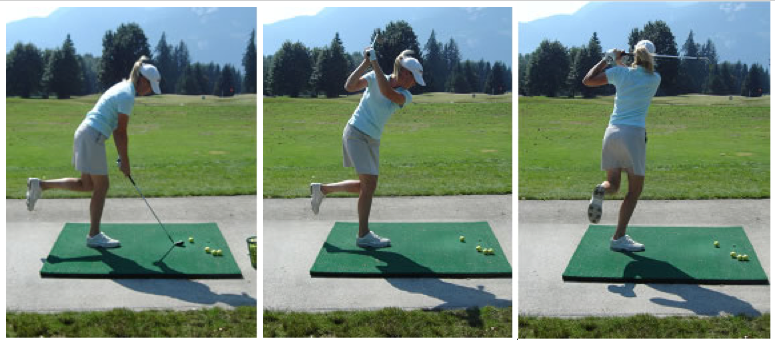
Training Factor #2: Flexibility
Flexibility is generally considered to be an important component of sport performance, injury prevention, and optimal health (United States Olympic Committee, teamusa.org).
Flexibility has been defined as the range of motion (ROM) around a single joint or a series of joints and reflects the ability of the muscle-tendon units to elongate within the physical restrictions of the joint (Hubley-Kozey, 1991, in Testing of the High Performance Athlete).
Dynamic (moving) flexibility has been associated with the opposition or resistance to movement. This is of particular importance to the sport of golf, where free movement is critical in developing optimal swing mechanics and club-head speed.
Paul Chek (2001) has suggested that golf flexibility is a descriptive term for the amount of movement, uninhibited by ROM restrictions that a golfer needs to play at their full potential.
“If you look at some of the players on tour who can really bomb it–guys like Hank Kuehne and Charles Howell–they’re not the most physically intimidating athletes. But they all are very flexible players who can generate tremendous club-head speed while swinging in balance. That’s also one of the keys to my power. I’m convinced that if you increase your flexibility, you’ll add power to your swing.” –Tiger Woods
This quote by Tiger Woods is supported by the laws of basic physics, that is that power = force (strength) x distance (flexibility) / time (greater club-head speed).
Thus, a golfer who is able to generate more force during their swing, through a greater range of motion in a shorter amount of time, will be the most powerful, and will achieve the greatest distance off the tee, or for a given shot, assuming that the mechanics of the swing and shot are sound.
Here are a few great stretches for golfers:
Rotors

Purpose:
To increase the rotation and coil of the body about the spine.
Instructions:
Standing tall with good posture and with feet shoulder width apart and hands on the hips, rotate your body as far as you can to one side. Look behind you to add to the stretch. Repeat to the other side.
Advanced:
Try this movement with your golf club across your shoulders. Another extension is to perform this movement while sitting on a Swiss ball.
Lying-down trunk rotation stretch

Purpose:
To increase the rotation and coil of the body about the spine. Also, to increase mobility between the shoulders and hips.
Instructions:
Lying down with both arms extended to either side, bring your knees up to 90 degrees. Keep your lower legs parallel to the floor
Single-leg downward dog

Purpose:
To stretch the hamstrings, calves, and lower back.
Instructions:
Lean forwards and place your hands on the ground as indicated in the diagram. Slowly try to create an “upside down V” with your arms, and back in a straight line up to your hips and your legs also straight in line to your hips. You can bend one knee to isolate the muscles in the opposite leg.
Upward dog

Purpose:
To stretch the lower back and hip flexor muscles. This is an excellent rehabilitation exercise for people with lower back pain.
Instructions:
Lying face-down on a mat, place your hands directly beneath your shoulders. While keeping your hips on the ground, slowly push your upper body up as far as possible. If you feel any pain in your lower back do not continue with this stretch.
Training Factor #3: Posture
Posture has been defined by Paul Chek (Golf Biomechanics Manual, 1999) as “the position from which movement begins and ends.”
Ramsay McMaster (2003) defines posture as “maintaining the primary and secondary curves of the spine”. These curves occur in your neck (cervical curve), your upper back (thoracic curve), and your lower back (lumbar curve).
These natural curves are supported by many postural muscles in each area – your neck, your back and shoulders, your lower back, and all through your abdominal area, including the muscles on the front of your abdomen. These muscles serve to hold the spine in position during movement, and to protect the spine from excessive movement.
Good posture is very important for the proper execution of the golf swing. It is important to prevent injury, as well as to ensure proper positioning at address, and throughout the swing. Good postural muscle strength will also prevent any unwanted movements from occurring. Ben Hogan (1985) writes that:
“Not only will good posture improve your ability to strike the ball more consistently, it will also improve power, stability and eliminate chronic golfing injuries.”
Examples of elite golfers executing proper postures at critical points of the swing are shown here. Note that the golfers are able to maintain an upright posture at address and throughout the swing. Also note that the natural curves of the spine are also retained.
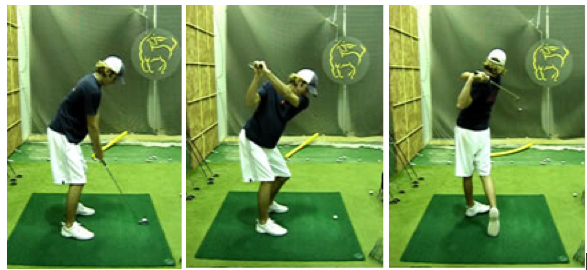
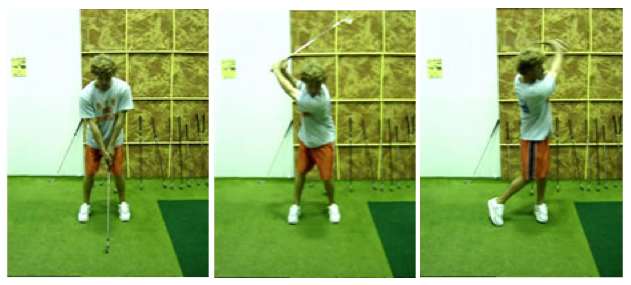
A simple push – pull exercise using a pulley system is a great way to practice holding great posture during rotational movements like the golf swing. The other benefit of this exercise is that it stretches your hip flexors and trains your core,
Start in a lunge position with the hand holding the pulley or tubing, then rotate the body forward as if you are punching:

You can do the reverse also to train the opposite muscles:
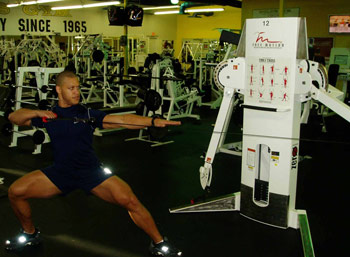
Training Factor #4: Core abdominal strength and stability
Golf performance depends on effective transfer and co-ordination of energy from the legs through the core and the arms, all of which hinges on strength and power of the core musculature.
Thus, good core strength will allow the golfer to develop the most power possible during the swing with optimal control. Further, core strength will stabilize the hips and spine improving body control during athletic movements. Perhaps most importantly good core strength will maintain back health and prevent injuries to the spine that can result from the golf swing.
The “core” is a common term used to refer to the middle section of the body between the lower part of the rib cage and the hips. This is the trunk of the body and includes the spine including the low back, all of the abdominal muscles, and your pelvis. There are 29 muscles in this area!
Core strengthening can be achieved by practicing specific exercises.
In addition to developing strength in these muscles, one must focus on muscular endurance. This is because these core stability muscles are used in most daily activities, not just while playing golf, and therefore they can be-come easily fatigued predisposing us to instability, injury, and poor golf mechanics.
When performing core strength and stability exercises, safety is of utmost importance due to the involvement of the spine. Athletes should always focus on balance and control while training the core muscles, and make sure a professional teaches the athlete proper technique before practicing them on their own.
If you have a history of back pain make sure you consult a physiotherapist of chiropractor before beginning a core strengthening program to make sure there are no underlying causes of your back pain or weakness.
For more information on core stability and back health refer to a book by Dr. Stuart McGill, a spine biomechanist, from the University of Waterloo. This book can be found at www.backfitpro.com.
For an excellent core strength program that is specifically designed for people who are rehabilitating from back injuries please look up Solid to the Core.
Here are a few basic core strength exercises to get you going.
Lower abdominal (transverse abdominus) activator

Purpose:
To increase activation of the lower abdominal muscles. This is a foundation exercise for all functional training as this contraction can be performed at any time during exercise to increase core stability and balance.
Instructions:
Lying on your back with your hands across your chest or placed on your lower abdomen, contract the muscles of your abdomen below your belly button all the way down to your pubic bone. Hold the contraction for 5 seconds and relax. Repeat as recommended. Advance to practicing this contraction while seated, then while standing, and then while walking.
Side raises

Purpose:
To increase strength of the abdominal oblique muscles.
Instructions:
Begin this exercise lying sideways on the ground placing your lower arm on the ground. Slowly lift the hips off the ground as far as possible while raising your other arm high above your head. Hold the raised position for at least 5 seconds. Repeat to the other side.
Sitting core rotations

Purpose:
To increase strength of the core rotor muscles and to increase flexibility in the lower back.
Instructions: Begin this exercise sitting on the floor. Bring the legs up off the ground and, with straight arms, slowly rotate your upper body to one side as far as possible in either direction. If you are unable to move equally in both directions, place extra emphasis on the tight side.
Plank stabilizer

Purpose:
To increase strength of the core stabilizer and shoulder muscles.
Instructions:
Starting in push up position, slowly raise one arm off the ground until it is parallel to the floor. Hold for at least 5 seconds and then repeat to the other side. The second level of this exercise is to perform the arm lifts while only using one foot to keep balance – thus one arm and the opposite foot are raised off the ground at the same time.
Training Factor #5: Strength and power for golf
Strength and power are essentials for any golfer and can help improve driving distance, as well as play from the fairway and also the accuracy of the short game.
The most obvious benefit of improved strength and power in golfing is the positive effect on club head speed, which can be increased dramatically with proper training. Fortunately, the effects of this type of training can be measured directly in driving distance.
Further, stronger and more powerful muscles will give you more fine motor control – meaning that because you are stronger, each swing is relatively less stressful, and the likelihood of making a mistake (however small) is decreased. Fine motor control can be measured in your accuracy – greens or fairways hit.
Perhaps most importantly, a comprehensive strength training program that works all muscles and joints (even those not necessarily used in the golf swing) will help reduce the chances of injury by ensuring that you have a strong and stable musculoskeletal system.
Now, there is a difference between strength and power. Strength is your maximal ability to contract a muscle. Power is how quickly you can achieve that contraction.
In essence, muscle power is the ability to apply a lot of force very quickly. Powerful movements are explosive and few movements in sport are as powerful as the golf drive.
To make an exercise more powerful and to train your muscles and joints to move quickly and accurately just decrease the weight that you might be lifting in the gym and increase the speed of your movements. Here’s an example of a national team golfer doing jumping lunges:
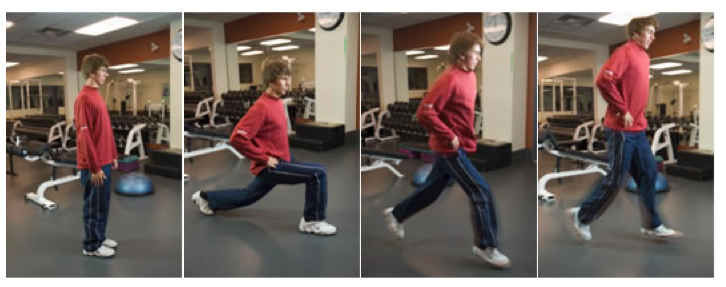
Strength exercises like push ups are great for golfers. To make these strength exercises golf specific you can add some imbalances as shown here.
Normal (basic):

Slightly unbalanced (intermediate):
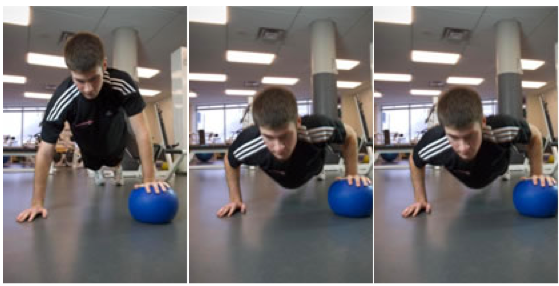
Very unbalanced (advanced):
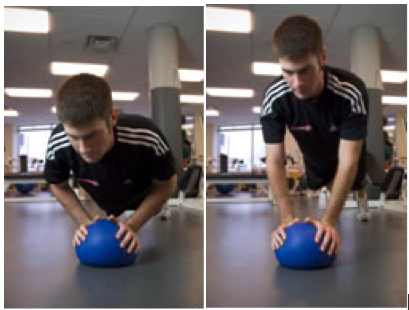
Training Factor #6: Cardiovascular Fitness
The aerobic cardiovascular system consists of the heart, lungs, and blood. This system supplies oxygen to the muscles which the muscles then use to produce energy for activity like walking, and for recovery from intense bursts of exercise like the golf swing.
Although golf is a sport that is thought to primarily require explosive power to perform the golf swing, and relaxed fine motor control for the short game and putting, the aerobic cardiovascular system is also of critical importance for the following reasons:
In a typical game a golfer will rely on their aerobic system to walk 7-10 kilometres, up and down hills, over varied terrain without fatigue.
A strong aerobic cardiovascular system will also help deal with mental stresses and helps people be able to relax under pressure situations.
In addition to the need for a strong aerobic cardiovascular system when playing a round of golf, the aerobic system is used extensively during practice when a golfer may be hitting shots repeatedly with minimal rest between practice repeats. Optimal muscle recovery between shots is dependent on how efficient the aerobic system is working and this will help golfers practice more effectively for longer periods of time.
Finally, balance and posture are crucial contributors to the performance of the golf swing itself, and are dependent on muscles that are active all day long (postural muscles and fine motor control muscles in the joints). These muscles are most likely to fatigue during the day, especially when walking long distances while performing explosive movements like the golf swing.
Therefore, aerobic conditioning of all of the muscles of the body, as well as the heart, lungs, and blood is very important for golfers who want to perform at their best.
Aerobic conditioning can be accomplished by performing any exercise for extended periods of time with a sustained heart rate.
Examples of exercises that enhance aerobic cardiovascular function include swimming, walking, jogging, running, skipping, step machine, and rowing.
Each of these activities has benefits and drawbacks which can affect your golf game. Make sure that when you start an aerobic training program, that you consult your golf professional or trainer and ensure that you monitor your playing ability to make sure that the training enhances your game.
Always finish your aerobic training sessions with golf-specific flexibility routines and drink plenty of fluids before, during and after your training sessions. Make sure you wear high – quality footwear that is designed for the type of activity you are doing, i.e. running shoes for running, cross training shoes for indoor training.
Learn more
Want to get in the best shape of your life, and stay that way for good? Check out the following 5-day body transformation courses.
The best part? They're totally free.
To check out the free courses, just click one of the links below.




Share